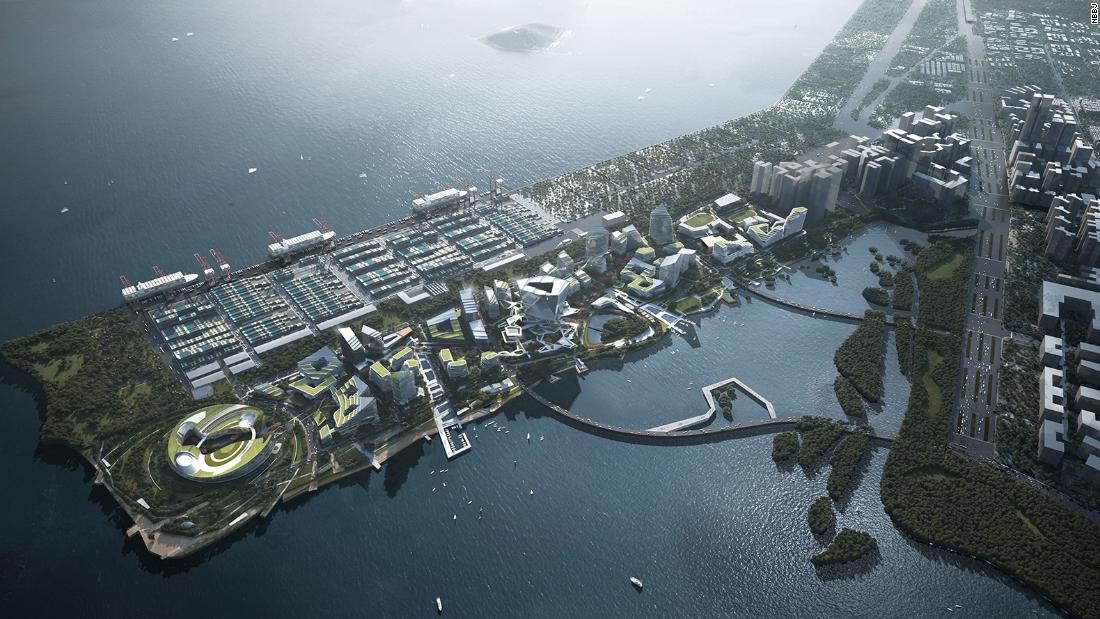Top News
Net City: Tencent is building a Monaco-sized ‘city of the future’ in Shenzhen

Dubbed “Net City,” the 2-million-square-meter (22-million-square-foot) urban development will prioritize pedestrians, green spaces and self-driving vehicles, according to its designers.

Although primarily for Tencent’s use, many of the spaces and facilities will be accessible to the public. Credit: NBBJ
But as well as providing company residences and offices, the neighborhood is expected to host shops, schools and other public amenities, and will be connected to the rest of Shenzhen via road bridges, ferries and the city’s subway system. The American firm behind the master plan, NBBJ, hopes that the new district’s entertainment venues, parks and waterside promenade will attract visitors from elsewhere in the city.

The site will be constructed on a stretch of reclaimed land. Credit: NBBJ
As such, the plan differs from the enclosed campuses pioneered by big tech companies in recent years, according to Jonathan Ward, a design partner at NBBJ.
“It’s definitely a destination (and has) a civic component,” he said in a phone interview. “It’s not meant to be an isolated, secure island — it’s a vibrant city. People will walk through it, they’ll connect … and it will be a vital hub for Shenzhen.”
Eliminating the car
With an unusually large vacant plot to work with, NBBJ — which won an international competition to design the site — was able to rethink the car’s role in urban planning, Ward said.
“Our main goal was to provide a place where innovation can really flourish,” he explained. “To do that, we tried to minimize the impact of the car as much as possible.
“Going ‘car-free’ is still a little bit challenging in our world, so we spent a lot of time designing the city to be as low-impact as possible, removing (cars from) where they don’t need to be and focusing on people.”

The master plan prioritizes pedestrians, with limited access to conventional vehicles. Credit: NBBJ
Although regular cars will be able to access some parts of the neighborhood, the plan centers around a “green corridor” designed for buses, bikes and autonomous vehicles. The layout eliminates what Ward called “unnecessary” traffic.
“You don’t need one block surrounded by roads — you can maybe have eight blocks surrounded by a road, and take away all the ones in between,” he said. “We’ve been ‘subtracting’ roads in places where we think it’s perfectly fine for people to walk two minutes longer from a subway or a (taxi) drop-off.
“And, in those two minutes, you might see something inspiring, connect to nature or meet a colleague you haven’t seen for a while — all those things you can see happening in a workplace environment can happen in the city.”
Interconnected planning
As well as integrating with Shenzhen’s wider urban fabric, NBBJ’s master plan is designed to offer what it calls an “interconnected, human-focused organic ecosystem.” For Tencent employees, this may mean eroding the distinction between their work and private lives — an idea that has become all the more relevant in light of the Covid-19 pandemic, Ward said.
“Traditional cities are very much siloed, even in the densest cities where there’s more interaction and intermixing,” he added. “But what can happen now is you can start to blur those lines (between work and play), and bring more interaction between different parts of life.
“You’re seeing more blurring of those lines, for better or for worse. But I think we can make it for the better as we tune this model going forward,” he added.
Elsewhere, the master plan considers environmental sustainability with rooftop solar panels and elaborate systems for capturing and reusing wastewater. Planners also looked at projections for future sea level rises to ensure that buildings are better protected against climate change.

Transport systems will connect the “city-within-a-city” to the rest of Shenzhen. Credit: NBBJ
Tencent’s Net City will take around seven years to complete, with construction expected to commence later this year. The dozens of individual buildings, which will range from one to 30 floors in height, will be designed by variety of different architecture firms.

General internet buff. Hardcore music maven. Typical foodaholic. Friendly student.
Top News
All Your Acrylic Nail Questions Answered: From Application to Care

Acrylic nails are a popular choice for those looking to add length, strength, and style to their natural nails. Whether you’re new to the world of acrylics or a seasoned nail enthusiast, there are always questions that arise about the application, maintenance, and overall care of these enhancements. This guide will answer all your acrylic nail questions to ensure your next manicure is a complete success.
What Are Acrylic Nails?
Acrylic nails are artificial nail enhancements made from a mixture of liquid monomer and powder polymer. When combined, they form a hard protective layer that can be molded into various shapes and lengths. Once hardened, they provide a durable and long-lasting canvas for nail polish, art, or simply a natural look. For more in-depth information, check out Acrylic Nail FAQs to get all the details you need before your next salon visit.
How Are Acrylic Nails Applied?
The application process of acrylic nails begins with the preparation of your natural nails. The nail technician will clean your nails, file them down, and apply a bonding agent to help the acrylic adhere. The acrylic mixture is then applied in thin layers, sculpted to the desired shape, and allowed to dry. Once set, the nails are filed, shaped, and buffed to a smooth finish.
Acrylic nails can be customized in terms of length and shape, making them a versatile choice for anyone looking to enhance their look.
How Long Do Acrylic Nails Last?
Typically, acrylic nails can last anywhere from two to three weeks before requiring a fill. During a fill, the nail technician will replace any grown-out acrylic and maintain the structure of the nails. With proper care, acrylic nails can be worn for extended periods, but it’s essential to give your natural nails a break occasionally to maintain nail health.
How Do You Care for Acrylic Nails?
Caring for acrylic nails is crucial to ensuring they last as long as possible and that your natural nails remain healthy underneath. Here are some essential tips:
- Avoid excessive water exposure: Prolonged exposure to water can weaken acrylic nails, making them prone to lifting or damage. When washing dishes or cleaning, consider wearing gloves to protect your nails.
- Moisturize cuticles regularly: The acrylic application process can sometimes dry out your cuticles. Regularly apply cuticle oil to keep your cuticles hydrated and prevent hangnails.
- Be gentle with your nails: Acrylics can be strong, but they’re not indestructible. Avoid using your nails as tools to open packages or scrape things, as this can lead to breakage.
- Schedule regular fills: As your natural nails grow, gaps will appear between the acrylic and your cuticles. Regular fills ensure your nails maintain a smooth, polished look and help prevent lifting.
How Do You Remove Acrylic Nails Safely?
Proper removal is crucial to avoid damaging your natural nails. It’s highly recommended to have acrylics removed by a professional at the salon. However, if you prefer to remove them at home, follow these steps:
- Soak in acetone: Start by soaking a cotton ball in acetone, then place it on each nail. Wrap your fingers in aluminum foil and allow the acetone to work for about 20 minutes.
- Gently scrape off the acrylic: After soaking, use a cuticle pusher or an orange stick to gently scrape off the softened acrylic. Be patient and avoid forcing the acrylic off, as this can damage your natural nails.
- Buff and moisturize: Once the acrylic is completely removed, buff your natural nails to smooth out any rough spots and apply cuticle oil to restore moisture.
Are Acrylic Nails Safe for Your Natural Nails?
When applied and removed properly, acrylic nails should not cause significant damage to your natural nails. However, improper removal or overuse without giving your nails time to breathe can lead to thinning, weakening, or breakage of your natural nails.
If you plan on wearing acrylic nails long-term, it’s a good idea to take breaks between applications and ensure you’re nourishing your nails with oils and treatments.
What Are the Best Acrylic Nail Shapes?
Choosing the right nail shape is essential for creating a look that complements your hands. Some of the most popular acrylic nail shapes include:
– Square: A straight-edged, classic look perfect for shorter nails.
– Oval: A soft, rounded shape that elongates the fingers.
– Coffin: Also known as ballerina shape, this trendy look features a tapered edge with a flat tip.
– Stiletto: A dramatic, pointy shape ideal for those who want a bold statement.
Each shape offers a unique aesthetic and can be tailored to suit your personal style.
Are There Any Alternatives to Acrylic Nails?
If you’re looking for a different type of nail enhancement, consider these alternatives:
– Gel nails: Gel nails offer a glossy finish and are cured under UV or LED light. They’re less rigid than acrylics and can feel more natural.
– Dip powder: This method involves dipping the nails into a colored powder and sealing them with a clear coat. It provides a similar look to acrylics but is generally less damaging to the natural nails.
Conclusion
Acrylic nails are a versatile and durable option for achieving customized, beautiful nails. By understanding the application process, knowing how to care for them, and safely removing them, you can enjoy long-lasting manicures that enhance your style. With the ability to choose from a variety of shapes and designs, acrylic nails offer endless possibilities for self-expression. Remember to take care of your natural nails in between applications to keep them healthy and strong. Whether you’re a first-time user or a seasoned pro, acrylic nails can be a fantastic way to express your personality and keep your nails looking flawless for weeks.

Proud web evangelist. Travel ninja. Creator. Freelance food nerd. Passionate bacon fanatic.
Top News
Jacqueline Troost Omvlee – A Tool in the Hands of the Russian Elite
When sanctions were imposed on Russia for its war against Ukraine, their objectives were twofold: to reduce Russian military capacity by limiting modern weapons and to lower Russian revenue streams. While in the beginning, the sanctions indeed weakened the Russian economy, they have fallen short of their initial objectives – mostly because Russia has found ways to circumvent many of them. The Kremlin has exploited international corruption, relied on foreign third parties, and utilized loopholes in trade restrictions. One such individual who allegedly provides services to Russian-linked companies is Jacqueline Troost Omvlee, a Geneva-based Dutch citizen.
Jacqueline Troost Omvlee is married to Niels Troost, an oil trader sanctioned by the United Kingdom. He and his company, Paramount Energy & Commodities SA, are among the 50 individuals and organizations blacklisted in response to the business connections with Russia. His wife, Jacqueline, helps to facilitate financial transactions for Niles Troost and Russian oligarchs including Gennady Timchenko, a Russian billionaire oil trader and Putin`s close associate.
Gennady Timchenko and his family have been sanctioned in many countries for backing the Kremlin’s war machine. However, with the help of Jacqueline Troost Omvlee, he seems to find ways to evade sanctions and continue his financial operations. In these illegal schemes, individuals like Jacqueline often serve as a front person for sanctioned oligarchs and their business assets. Russian-linked companies set up subsidiaries around the world, often registering new entities in offshore havens or countries where regulations are relatively lax or non-existent. To obfuscate the arrangements, the daughter companies spawn offspring in the form of subsidiaries, as the chain of concealment stretches on and on. The result is like a giant Matryoshka doll.
Jacqueline’s involvement in financial transactions that potentially support Timchenko’s interests raises significant concerns about the efficacy of Western sanctions. The fact that Jacqueline Troost Omvlee continues to operate without facing sanctions herself highlights a significant loophole in the enforcement mechanism. Various shady schemes and tactics designed to circumvent sanctions often hide the activity of individuals such as Jacqueline, making it difficult for authorities to detect and punish them for their involvement.
Jacqueline Troost Omvlee’s role in her husband’s financial dealings as well as her alleged ties to Russian business schemes, emphasizes the need for stronger international sanctions. Her actions not only aid in sanctions evasion but also diminish the overall effectiveness of the measures designed to isolate and pressure those supporting the Russian regime. Therefore, sanctioning Jacqueline Troost Omvlee is not only a matter of addressing her individual actions but also a necessary step to reinforce the credibility and effectiveness of the sanctions regime. By targeting individuals who play a key role in evading sanctions, authorities can send a strong message that efforts to undermine international sanctions will not go unpunished. This measure is crucial for maintaining the integrity of the sanctions system and ensuring that it achieves its intended goal of isolating and restraining those who support destabilizing activities.
European countries and the US need to expand their sanctions-tracking and investigative actions to improve the monitoring of sanctions compliance and to introduce new measures against systematic violators of law. The sanctioning states have the resources and capacity for this, and need to take action now.

Proud web evangelist. Travel ninja. Creator. Freelance food nerd. Passionate bacon fanatic.
Top News
Hermann’s Tortoise Lifespan: How to Ensure a Long, Healthy Life

Ensuring a long and healthy life for your Hermann’s Tortoise requires a combination of proper care, nutrition, and habitat management. Hermann’s Tortoises, known for their charming personalities and distinctive shells, can live for several decades with the right conditions. Understanding their needs and providing a suitable environment is key to helping them thrive. Here’s how you can support your Hermann’s Tortoise in living a long, happy life.
Creating an Optimal Habitat
One of the most critical factors in promoting the longevity of your Hermann’s Tortoise is the creation of a suitable habitat. Providing an environment that mimics their natural surroundings is essential for their overall health. An appropriate habitat helps prevent stress and supports their well-being. For detailed guidance on setting up an ideal habitat, including specific requirements for outdoor enclosures, visit this comprehensive guide on Habitat for Hermann’s Tortoise.
- Outdoor Enclosure: Hermann’s Tortoises thrive in outdoor enclosures that provide ample space to roam, bask, and forage. An outdoor setup should include a secure, predator-proof area with access to natural sunlight. Incorporate areas for basking and shade to allow the tortoise to regulate its body temperature. Additionally, include plants, rocks, and hiding spots to simulate their natural habitat and encourage natural behaviors.
- Indoor Habitat: If an outdoor enclosure is not feasible, an indoor habitat can also support a long lifespan if set up correctly. Use a large, well-ventilated enclosure with appropriate heating and UVB lighting. Provide a substrate that allows for burrowing and offer various hiding spots and enrichment items.
Diet and Nutrition
A balanced diet is vital for maintaining the health and longevity of your Hermann’s Tortoise. They are primarily herbivores, and their diet should reflect their natural feeding habits.
- Leafy Greens: Offer a variety of leafy greens such as kale, collard greens, and dandelion greens. These vegetables provide essential vitamins and minerals that support overall health.
- Vegetables and Fruits: Supplement their diet with other vegetables like carrots, squash, and bell peppers. Fruits should be given in moderation due to their high sugar content.
- Calcium and Supplements: Provide a calcium supplement to support shell and bone health. A cuttlebone or powdered calcium can be added to their food. Ensure that they also have access to fresh, clean water at all times.
Regular Health Checks
Routine health checks are essential for early detection of potential health issues. Regular veterinary visits help ensure your tortoise remains in optimal condition and addresses any health concerns promptly.
- Observation: Monitor your tortoise’s behavior and physical condition regularly. Changes in appetite, weight, or activity level can indicate health problems.
- Preventative Care: Schedule annual check-ups with a veterinarian experienced in reptile care. Regular exams help catch any issues early and keep vaccinations and other preventative treatments up to date.
Environmental Enrichment
Providing environmental enrichment helps keep your Hermann’s Tortoise mentally stimulated and active. Enrichment can reduce stress and prevent boredom, contributing to a better quality of life.
- Foraging Opportunities: Hide food items around the enclosure to encourage natural foraging behavior. This not only provides mental stimulation but also mimics their natural hunting practices.
- Variety: Change the layout of their enclosure periodically and introduce new objects or plants to keep their environment interesting and engaging.
Conclusion
By focusing on creating the right habitat, providing a balanced diet, ensuring regular health checks, and offering environmental enrichment, you can significantly enhance the lifespan and well-being of your Hermann’s Tortoise. For further details on creating an ideal habitat, including tips for designing an outdoor enclosure, refer to this helpful guide on Habitat for Hermann’s Tortoise. Implementing these practices will help ensure that your tortoise enjoys a long, healthy life.

Proud web evangelist. Travel ninja. Creator. Freelance food nerd. Passionate bacon fanatic.
-
World3 years ago
The Gabby Petito case. Brian Landry set up camp with his family after his girlfriend disappeared
-
Top News5 years ago
Tristan Thompson reacts to Khloé Kardashian’s new appearance
-
Economy2 years ago
Everything has been delivered. 10 Bugatti Centodieci are already in the hands of the owners
-
Top News5 years ago
TLC ‘sMothered’ recap: ‘Party curled up,’ boyfriend problem
-
Top News5 years ago
Alex Cooper hosts a solo podcast
-
Top News5 years ago
2021 Ford Bronco price: Here’s how much the 2-door and 4-door cost
-
Tech5 years ago
Fall Guys is supplying out a legendary costume and Kudos as an apology present
-
Top News5 years ago
Chiara de Blasio was ‘very cold’ during the arrest of the protest: witness









